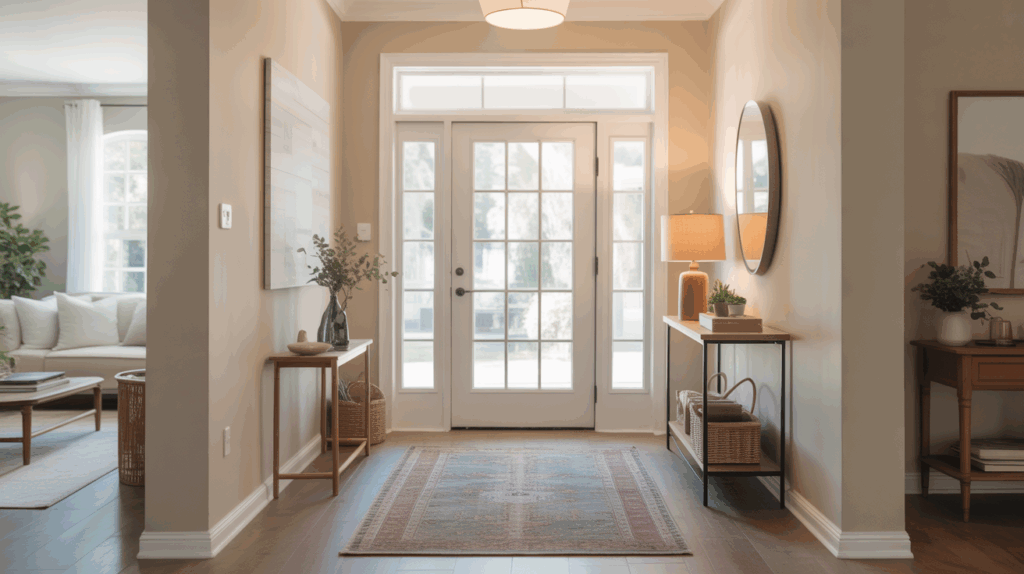Have you ever opened your front door and found yourself standing right in the middle of your living room? If so, you’re not alone. Many homes don’t have a separate entryway, and it can make things feel a little awkward or unfinished.
I used to have the same problem in my home. Shoes were piled near the door, bags were dropped on the floor, and no clear place to pause when coming in. It always felt like something was missing. That’s when I realized I needed a foyer, even though I didn’t have a hallway.
A foyer is more than just a space. It helps set the tone for your home and keeps things organized. With just a few simple changes, I created a cozy, welcoming entry in my open living room—and you can too. Let me show you how, step by step, using things you may already have.
What is a Foyer?

Think of a foyer as the “welcome area” of your home. It’s the first place people see when they walk in. In some houses, it’s a large space with a table, mirror, and coat closet. In other homes—like mine and maybe yours—it’s just a small corner near the door.
But size doesn’t matter here. What matters is the feeling it gives you.
Your foyer should make you feel calm, not cluttered. It should give you a place to take off your shoes, set down your bag, and breathe before stepping into the rest of the room.
It’s that little pause you didn’t know you needed—until you have it. So even if you have no entry hall, you can still create a foyer that feels just right for your home.
How to Make a Foyer in Your Living Room
Now that you understand what a foyer is and why it matters, let’s talk about how to actually make one. You don’t need to knock down walls or build something new. You just need to use what you already have in a smarter way.
The tips below come from my own experience and ideas I’ve seen work well in friends’ homes too. Whether you have a tiny space or a wide-open layout, these simple steps will help you turn part of your living room into a warm, useful entry area.
1. Look at Your Space First

Take a moment right now to walk to your front door and look around. Where do you naturally step when you enter? Is there a little bit of wall nearby? Maybe a corner that always feels empty? I found that just noticing the space helped me come up with ideas I hadn’t seen before.
Your perfect foyer spot might already be there—you just haven’t used it yet. Think of it as finding the “pause point” between outside and inside. That’s where your foyer begins.
2. Define the Area with a Rug

One of the first things I added was a small rug. It instantly told me, “This is where the entry starts.” It was such a simple thing, but it made a huge difference.
Pick a rug that feels a little different from your main living room rug—maybe a new color or texture. It doesn’t need to be big. Mine is just big enough to catch shoes and water from rainy days.
A rug not only protects your floor, but it also helps people know where to stop, take off their shoes, and settle in.
3. Add a Console Table or Shelf

Once the rug was down, I added a narrow table against the wall. It gave me a place to drop my keys and mail when I walked in.
If you don’t have space for a table, a small shelf works just as well. I once helped a friend install a floating shelf right near her door—just enough space for a candle and a little bowl for change. That small touch made her open living room feel more structured, without taking up any extra space.
4. Use Wall Space for Decor and Storage

Above my table, I hung a mirror. Not only does it make the space feel bigger, but it’s also great for a quick check before heading out. If mirrors aren’t your style, you can use artwork, a favorite quote, or even a family photo.
That little detail adds so much warmth. I also added a few hooks beside the table for coats and bags. You can use peel-and-stick hooks if you rent or don’t want to drill.
It’s amazing how useful that bit of wall can be once you start using it.
5. Divide the Space with Smart Pieces

If your front door opens right into the center of your living room, like mine used to, it might feel like there’s no way to set the space apart. But even something simple—like a tall plant or a standing shelf—can do the trick.
I once used a tall, open-backed bookcase to separate my entry from the rest of the room. It didn’t block light, but it gave just enough structure. One of my neighbors used a screen with fabric panels, and it looked beautiful and gave her some privacy too.
6. Use Lighting to Mark the Entry

Lighting makes a huge difference. I added a small table lamp to my console, and suddenly the space felt cozy and welcoming, especially in the evenings.
If you can hang a small light above the entry area, even better. It shows that this space is special, not just part of the living room. One friend of mine used a battery-powered wall sconce with a remote because her space didn’t have any outlets nearby.
There’s always a way to bring in warm light, even if it’s just a plug-in lamp on a shelf.
7. Change the Wall Color or Texture

When I wanted to go a step further, I painted just a small section of the wall near my door. It was the same color family as the rest of the room, just a bit darker. That one change made the space feel more grounded.
You can also try wallpaper or peel-and-stick wall decals for texture or color. I’ve seen people use wood slats, brick stickers, or even fabric panels. It all depends on what makes you smile when you walk through the door.
8. Add Storage to Stay Organized

The biggest benefit of having a foyer is keeping clutter out of the rest of the room. I added a small bench with baskets underneath for shoes, and it changed everything. Before, shoes were scattered everywhere. Now they have a home.
You can also use a small cabinet, a bin by the door, or a basket under a table. I even added labels on mine to help my kids know where their stuff goes. Storage doesn’t have to be fancy—it just has to make life easier.
9. Keep Kids and Pets in Mind

Speaking of kids, if you have little ones, try hanging hooks lower on the wall so they can hang up their own coats and backpacks. It saves you time and teaches them to be organized.
I also have a dog, so I keep a small bin near the door for her leash, treats, and waste bags. It’s easy to grab things when we go out, and I don’t have to search all over the house.
Make your foyer work for your whole family, pets included.
10. Add Small Personal Touches

Don’t forget the fun stuff. I added a little welcome mat that says “Home Sweet Home,” and it makes me smile every time I walk in. You could use a photo of your family, a plant, or even a scented candle. It’s the little touches that make your foyer feel warm and personal.
You don’t need to spend much—just pick things that feel like “you.” That way, your foyer doesn’t just look good—it feels good too.
11. Keep it Simple and Neat

I’ve found that less is more. When my foyer had too many things, it started to feel messy again. Now I keep only the things I really use—shoes, keys, coats, and a few decorations. I clean it once a week and remind everyone where things belong.
When your entry is clean and simple, the whole house feels calmer. You don’t have to do it all at once. Just start with one small change, and you’ll see how quickly it adds up.
When to Refresh Your Foyer?
Over time, your needs might change, and that’s okay. What works today might not work a year from now. I like to update my foyer at the start of each season.
In the fall, I add a basket for scarves and a hook for coats. In the summer, I switch it out for beach bags and sunscreen. If you have kids, your storage needs may grow. If you get a new pet, you might need a new bin or tray.
Refreshing the space every few months keeps it useful and clean. It also gives you a chance to make the area feel fresh again. A small update, like a new rug or artwork, can make the whole space feel brand new.
Common Mistakes to Avoid
As you work on creating your foyer, try not to overthink or overfill the space. One mistake I made at first was trying to add too much.
I had baskets, shelves, hooks, a bench—and suddenly the area looked messy again. Keep it simple and clear. You only need a few useful items. Also, avoid blocking the walkway.
Your foyer should guide people in, not make them feel stuck. Another common mistake is skipping lighting. If the area looks dark or dull, it won’t feel inviting. A small lamp or soft light makes all the difference.
Finally, try not to ignore your lifestyle. If you always drop your bag or shoes in one spot, use that as a clue. Build your entry area around how you already live, not how you think it “should” look.
Conclusion
Now that you’ve seen how to create a foyer in an open living room, I hope you feel inspired to give it a try. It doesn’t take a huge budget or big furniture.
You just need to notice the space, make a few small changes, and add your own personal touch. I’ve done it in my own home, and I’ve helped friends do it too—and every time, the result is the same: a more welcoming, organized space that feels like home.
Whether you live in a small apartment or a large house, your entry can still feel special. Use a rug to define the space, a table or shelf to keep things tidy, and lighting to make it warm. Add storage that fits your needs, and don’t forget to include things that make you smile.
Take a walk to your front door, look around, and imagine what your foyer could be. Then start with one change today. I promise, it’ll be worth it.

